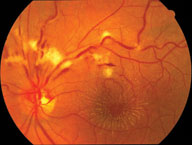 In branch retinal vein occlusion (BRVO) there is a tendency for the occlusive thrombus to occur at arteriovenous crossings, where the stiff-walled atheromatous artery may compress the lumen of the adjacent thin-walled vein, creating blood turbulence and thrombotic build-up.
In branch retinal vein occlusion (BRVO) there is a tendency for the occlusive thrombus to occur at arteriovenous crossings, where the stiff-walled atheromatous artery may compress the lumen of the adjacent thin-walled vein, creating blood turbulence and thrombotic build-up.
BRVO shows a strong association with systemic diseases such as hypertension, diabetes and hyperlipidaemia, as well as with arterial diseases such as atherosclerosis and carotid artery disease, temporal arteritis, and hypercoagulation or vasculitis disorders. The condition is also associated with ocular conditions, including raised intraocular pressure (IOP), Von Hippel disease, Coats disease and Eales disease.
SYMPTOMS
The patient may notice a BRVO if it affects a large area of retina or the macula itself. There may be a prior history of brief loss of vision (amaurosis fugax), transient ischaemic attack (TIA), or stroke (cerebrovascular accident).
Register now to continue reading
Thank you for visiting Optician Online. Register now to access up to 10 news and opinion articles a month.
Register
Already have an account? Sign in here
